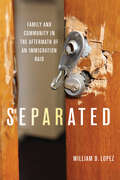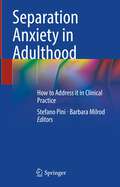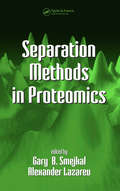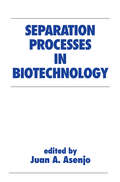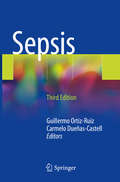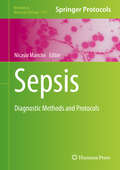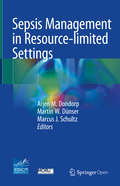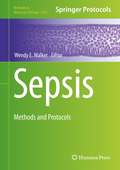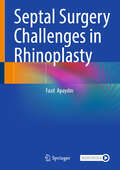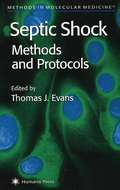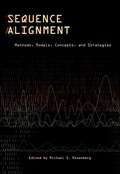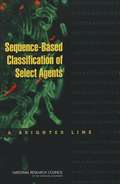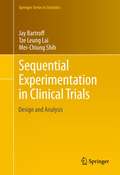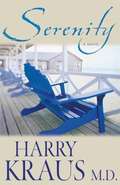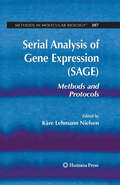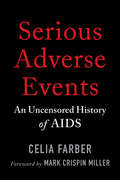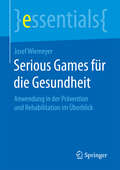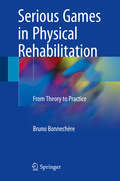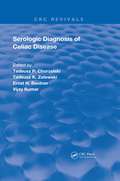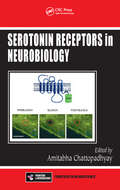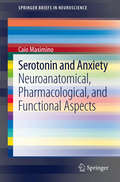- Table View
- List View
Separated: Family and Community in the Aftermath of an Immigration Raid
by William D. LopezWilliam D. Lopez details the incredible strain that immigration raids place on Latino communities—and the families and friends who must recover from their aftermath.2020 International Latino Book Awards Winner First Place, Mariposa Award for Best First Book - Nonfiction Honorable Mention, Best Political / Current Affairs BookOn a Thursday in November 2013, Guadalupe Morales waited anxiously with her sister-in-law and their four small children. Every Latino man who drove away from their shared apartment above a small auto repair shop that day had failed to return—arrested, one by one, by ICE agents and local police. As the two women discussed what to do next, a SWAT team clad in body armor and carrying assault rifles stormed the room. As Guadalupe remembers it, "The soldiers came in the house. They knocked down doors. They threw gas. They had guns. We were two women with small children... The kids terrified, the kids screaming."In Separated, William D. Lopez examines the lasting damage done by this daylong act of collaborative immigration enforcement in Washtenaw County, Michigan. Exploring the chaos of enforcement through the lens of community health, Lopez discusses deportation's rippling negative effects on families, communities, and individuals. Focusing on those left behind, Lopez reveals their efforts to cope with trauma, avoid homelessness, handle worsening health, and keep their families together as they attempt to deal with a deportation machine that is militarized, traumatic, implicitly racist, and profoundly violent. Lopez uses this single home raid to show what immigration law enforcement looks like from the perspective of the people who actually experience it. Drawing on in-depth interviews with twenty-four individuals whose lives were changed that day in 2013, as well as field notes, records obtained under the Freedom of Information Act, and his own experience as an activist, Lopez combines rigorous research with moving storytelling. Putting faces and names to the numbers behind deportation statistics, Separated urges readers to move beyond sound bites and consider the human experience of mixed-status communities in the small towns that dot the interior of the United States.
Separation Anxiety in Adulthood: How to Address it in Clinical Practice
by Barbara Milrod Stefano PiniThis book presents data that challenges the long-established view that separation anxiety disorder should be reserved for diagnosis among children and adolescents by demonstrating that adult-onset is prevalent in many countries and that adult-onset separation anxiety disorder is just as persistent and impairing as the pediatric-onset form. Separation anxiety disorder in adulthood is associated with high levels of disability. Research and clinical data indicate that overlooking the diagnosis of adult separation anxiety disorder may result in substantial costs in the form of disability and suffering.Over the last decades, the Psychiatry School of Pisa, in the person of Director Giovanni B. Cassano, M.D. and Stefano Pini, M.D. has conducted seminal studies in this area and brought research data into clinical practice. At the same time, the Pisa School has made a paramount contribution to the DSM-5 reformulation of adult separation anxiety disorder, which has since been transferred to the Anxiety Disorders chapter. Barbara Milrod, M.D. is an unusual clinical investigator. She has conducted clinical research in separation anxiety disorder, panic disorder and post-traumatic stress disorder for the past two decades. She has incorporated separation anxiety constructs into her approach to mechanisms of psychotherapy research across these disorders, and in affect-focused psychotherapies.The book consists of 10 chapters organized into two sections: a General Principles Section and Diagnosis and Treatment Section. The first section focuses on the biological underpinnings of separation anxiety and on the historical pathways that led to its DSM-5 categorization; the second elaborates on clinical topics, preventive strategies and treatments. This book will help the reader to understand and diagnose separation anxiety disorder and to bear it in mind during the differential diagnosis of patients of all ages presenting not only with anxiety but also with a variety of psychiatric and behavioral disorders.
Separation Methods In Proteomics
by Gary B. Smejkal Alexander LazarevDriven by the widespread growth of proteomic practices, protein separation techniques have been refined to minimize variability, optimize particular applications, and adapt to user preferences in the analysis of proteins.Separation Methods in Proteomics provides a comprehensive examination of all major separation techniques for proteomic
Separation Processes in Biotechnology (Biotechnology And Bioprocessing Ser. #9)
by Juan A. AsenjoEdited to avoid duplication and favor comprehensiveness, 20 contributors detail the recovery, separation, and purification operations of bioprocess technology. Individual chapters in this classic yet still highly relevant work emphasize concepts that are becoming more and more important when applied to the large scale versions of techniques that are considered well established. Aside from fully discussing processes, Separation Processes in Biotechnology includes sections on concentration separation and operation, purification operations, and product release and recovery. It also discusses plant operation and equipment and delves into economic considerations
Separations Technology: Pharmaceutical and Biotechnology Applications
by Wayne P. OlsonAuthored by a team of respected scientists and technologists, this book covers many pharmaceutical and biotechnology separations methods currently in use. Practical applications and descriptions are offered for air elutriation, microporous filtration, ultrafiltration, phase partitioning, crystallization, and chromatographic technologies such as adsorption, affinity, chelate, ion-exchange, size-exclusion, template, hydrophobic interaction, biotransformations, and chiral separations.Containing hundreds of references and a complete index, this book is designed for research and development scientists, process optimization engineers, and quality control laboratory scientists as well as quality assurance professionals and others needing to understand current separation techniques.
Sepsis
by Guillermo Ortiz-Ruiz Carmelo Dueñas-CastellSepsis or septic shock is a type of condition/infection which represents one of the leading post-surgical or post-traumatic complications. Sepsis is the major cause of morbidity and mortality in intensive care units worldwide. Also, sepsis is the leading cause of death in non-coronary patients, with pulmonary sepsis accounting for most cases as it relates to lung dysfunction. This is a concise, practical softcover volume devoted to covering only the most practical information for physicians. Charts, tables, and other figures are used to illustrate easy-to-follow treatment guidelines for those professionals who regularly treat patients in the ICU.
Sepsis
by Nicholas S. Ward Mitchell M. LevyThis book is designed to provide a comprehensive and state-of-the-art resource for clinicians who care for patients with sepsis, wherever they practice. Patients with severe sepsis requiring ICU admission have very high rates of ICU and overall hospital mortality, with estimates ranging from 18 to 50%. Risk factors for death from sepsis include underlying illness, increased age, and multi-system organ failure. This is compounded by the significant variation in the management of early severe sepsis. Care of these patients and clinical conditions can be quite complex, and materials are collected from the most current, evidence-based resources. Book sections have been structured to review the overall definitions and epidemiology of sepsis as well as current insights into the pathophysiology of sepsis. This review summarizes the evidence for the international consensus guidelines for the identification and management of sepsis. The latter part of this book reviews emerging concepts and approaches in the diagnosis and management of sepsis that may significantly reduce mortality in the future. Sepsis: Pathophysiology, Definitions and the Challenge of Bedside Management represents a collaboration between authors drawn from a variety of disciplines and contributions from basic scientists and highly recognized clinical opinion leaders with expertise in clinical trials.
Sepsis
by Nicasio ManciniThis volume covers microbiological, clinical and patophysiological aspects of sepsis and also provides general overview chapters with every chapter discussing the real clinical impact of the discussed diagnostic approaches. Sepsis is a major clinical problem that takes an inordinate toll on human lives and economical resources. It is widely recognized that inappropriate treatment is associated with a dramatic increase in mortality, especially within the first hours, therefore clinical and microbiological diagnosis are of pivotal importance in the management of septic patients. Written in the successful Methods in Molecular Biology series format, chapters include introductions to their respective topics, lists of the necessary materials and reagents, step-by-step, readily reproducible protocols, and notes on troubleshooting and avoiding known pitfalls. Authoritative and easily accessible, Sepsis: Diagnostic Methods and Protocols seeks to serve both professionals and novices with its well-honed methodologies in an effort to further our knowledge of this life-threatening illness.
Sepsis Management
by Jordi Rello Thiago Lisboa Jeffrey LipmanThis book is unique in approaching multiple organ dysfunction syndrome (MODS) from the perspective of its pathophysiological mechanism, and addressing aspects that are overlooked in most of the available literature. Eminent experts in the field from Europe and beyond offer new insights into risk stratification, severity assessment, and management of critically ill patients with sepsis. The principal focus is on recently developed concepts in infection management and in antibiotic use, bearing in mind that in these patients the pharmacokinetics of antibiotics are altered, affecting renal clearance and requiring dosage adjustments. The significance of the PIRO (predisposing factors, infection, response, organ dysfunction) model in the development of effective treatment strategies is emphasized. This book will be of interest and value to all who are involved in the treatment of, or research into, sepsis and MODS.
Sepsis Management in Resource-limited Settings
by Martin W. Dünser Arjen M. Dondorp Marcus J. SchultzThis book is open access under a CC BY 4.0 license. It constitutes a unique source of knowledge and guidance for all healthcare workers who care for patients with sepsis and septic shock in resource-limited settings.More than eighty percent of the worldwide deaths related to sepsis occur in resource-limited settings in low and middle-income countries. Current international sepsis guidelines cannot be implemented without adaptations towards these settings, mainly because of the difference in local resources and a different spectrum of infectious diseases causing sepsis. This prompted members of the Global Intensive Care working group of the European Society of Intensive Care Medicine (ESICM) and the Mahidol-Oxford Tropical Medicine Research Unit (MORU, Bangkok, Thailand) - among which the Editors – to develop with an international group of experts a comprehensive set of recommendations for the management of sepsis in resource-limited settings. Recommendations are based on both current scientific evidence and clinical experience of clinicians working in resource-limited settings. The book includes an overview chapter outlining the current challenges and future directions of sepsis management as well as general recommendations on the structure and organization of intensive care services in resource-limited settings. Specific recommendations on the recognition and management of patients with sepsis and septic shock in these settings are grouped into seven chapters. The book provides evidence-based practical guidance for doctors in low and middle income countries treating patients with sepsis, and highlights areas for further research and discussion.
Sepsis: Methods and Protocols (Methods in Molecular Biology #2321)
by Wendy E. WalkerThis detailed volume presents a variety of animal models that are commonly used to study sepsis and some key procedures to measure specific disease outcomes. The chapters describe well-established surgical and nonsurgical rodent models of sepsis, presented by experts in the field. In addition, the book includes protocols for burn injury and sepsis, modeling the mouse intensive care unit (MICU), and the development of humanized mice, which may be useful tools to increase the translational potential of rodent sepsis research. There is a chapter discussing the use of biomarkers for sepsis diagnosis and prognosis in humans and mice, as well as chapters describing specific methods for biomarker measurement, and the use of analgesics and humane endpoints in rodent sepsis research. Finally, agent-based computational modeling is presented as a valuable complementary approach to study sepsis. Written for the highly successful Methods in Molecular Biology series, chapters include introductions to their respective topics, lists of the necessary materials and reagents, step-by-step, readily reproducible laboratory protocols, and tips on troubleshooting and avoiding known pitfalls. Authoritative and practical, Sepsis: Methods and Protocols serves as an ideal guide for researchers working toward improving the identification and treatment of septic patients.
Septal Surgery Challenges in Rhinoplasty
by Fazıl ApaydınAlthough rhinoplasty is nowadays a frequently performed intervention, it is still a most complex procedure in facial plastic surgery, due to the crucial issue of careful nasal septum management and related nasal obstructions. Thought as a go-to resource and resulting from the author’s/editor’s lifelong surgical practice and research work, this carefully crafted volume covers the topic of nasal septum management in its entirety, supporting the reader with a wealth of full colour original illustrations and drawings. Each chapter is also enriched by surgical videos to foster the reader’s understanding and preparation of practical steps and best choices, offering direct support in the operating room. The chapters move from the history of nasal septum management and the examination of the necessary surgical anatomy to the preoperative nose examination and planning. The following chapters on the classification of septal deviation and the review of the different incisions and approaches bring to the examination of the traditional surgical methods (SMR, Cottle, Subtotal, extracorporeal). The contents then illustrate caudal septal deflections and a number of specific deviations in related chapters (dorsal, dorso-caudal and bony deviations). A particular chapter is devoted to dorsum preservation and nasal septum, the event of septal perforation, as well as ancillary procedures and packing and splinting. Septal Surgery Challenges in Rhinoplasty is especially thought for residents and specialists in the field of otorhinolaryngology and plastic surgery, who desire to consolidate their management skills in this demanding yet inspiring field of surgery.
Septic Shock Methods and Protocols
by Thomas J. EvansAn interdisciplinary panel of expert investigators describe proven methods for investigating the often deadly mechanisms of septic shock. Drawing on insights from a wide variety of fields-ranging from molecular and cellular biology to the physiological measurement of entire animals-these experienced research workers detail the most important techniques for studying sepsis involving endotoxins, toxins derived from Gram-positive organisms, cytokines, nitric oxide and other reactive nitrogen intermediates, and primary cell cultures. They also treat a number of significant techniques that are not well described in the literature, including the the Limulus endotoxin assay, the bioassay of TNF, the purification of bacterial endotoxin and superantigens, and the culture of primary human cells. Multidisciplinary and state-of-the-art, Septic Shock Methods and Protocols offers both experimental and clinical investigators a gold-standard collection of key methods for illuminating the basic pathophysiological processes that occur following infection.
Sequence Alignment: Methods, Models, Concepts, and Strategies
by Michael S. RosenbergThe sequencing of the human genome involved thousands of scientists but used relatively few tools. Today, obtaining sequences is simpler, but aligning the sequences--making sure that sequences from one source are properly compared to those from other sources--remains a complicated but underappreciated aspect of comparative molecular biology.
Sequence-Based Classification of Select Agents: A Brighter Line
by National Research Council of the National AcademiesSelect Agents are defined in regulations through a list of names of particularly dangerous known bacteria, viruses, toxins, and fungi. However, natural variation and intentional genetic modification blur the boundaries of any discrete Select Agent list based on names. Access to technologies that can generate or 'synthesize' any DNA sequence is expanding, making it easier and less expensive for researchers, industry scientists, and amateur users to create organisms without needing to obtain samples of existing stocks or cultures. This has led to growing concerns that these DNA synthesis technologies might be used to synthesize Select Agents, modify such agents by introducing small changes to the genetic sequence, or create entirely new pathogens. Amid these concerns, the National Institutes of Health requested that the Research Council investigate the science and technology needed to replace the current Select Agent list with an oversight system that predicts if a DNA sequence could be used to produce an organism that should be regulated as a Select Agent. A DNA sequence-based system to better define when a pathogen or toxin is subject to Select Agent regulations could be developed. This could be coupled with a 'yellow flag' system that would recognize requests to synthesize suspicious sequences and serve as a reference to anyone with relevant questions, allowing for appropriate follow-up. Sequence-Based Classification of Select Agents finds that replacing the current list of Select Agents with a system that could predict if fragments of DNA sequences could be used to produce novel pathogens with Select Agent characteristics is not feasible. However, it emphasized that for the foreseeable future, any threat from synthetic biology and synthetic genomics is far more likely to come from assembling known Select Agents, or modifications of them, rather than construction of previously unknown agents. Therefore, the book recommends modernizing the regulations to define Select Agents in terms of their gene sequences, not by their names, and called this 'sequence-based classification.'
Sequential Experimentation in Clinical Trials
by Mei-Chiung Shih Tze Leung Lai Jay BartroffSequential Experimentation in Clinical Trials: Design and Analysis is developed from decades of work in research groups, statistical pedagogy, and workshop participation. Different parts of the book can be used for short courses on clinical trials, translational medical research, and sequential experimentation. The authors have successfully used the book to teach innovative clinical trial designs and statistical methods for Statistics Ph.D. students at Stanford University. There are additional online supplements for the book that include chapter-specific exercises and information. Sequential Experimentation in Clinical Trials: Design and Analysis covers the much broader subject of sequential experimentation that includes group sequential and adaptive designs of Phase II and III clinical trials, which have attracted much attention in the past three decades. In particular, the broad scope of design and analysis problems in sequential experimentation clearly requires a wide range of statistical methods and models from nonlinear regression analysis, experimental design, dynamic programming, survival analysis, resampling, and likelihood and Bayesian inference. The background material in these building blocks is summarized in Chapter 2 and Chapter 3 and certain sections in Chapter 6 and Chapter 7. Besides group sequential tests and adaptive designs, the book also introduces sequential change-point detection methods in Chapter 5 in connection with pharmacovigilance and public health surveillance. Together with dynamic programming and approximate dynamic programming in Chapter 3, the book therefore covers all basic topics for a graduate course in sequential analysis designs.
Serenity
by Harry KrausFrom the back cover Can a quaint tourist town like Serenity live up to its name? Nothing exciting ever happens in Serenity, North Carolina. At least, that's what two newcomers to this coastal town are hoping. Adam, filling a surgical vacancy in the county hospital, wants to find the respect and money he feels he deserves. Beth, a single mom, hopes to heal the wounds from the past and reconnect with her searching teen. They came seeking solace and a new beginning, but found scandal, the hint of murder, and ...the possibility of love. A Story for those who need a reminder that God loves us as we are and not as we pretend to be. Bestselling author Harry Kraus, M.D. (www.cuttingedgefiction.com) Uses his experiences as a practicing surgeon to bring authenticity to his novels. He has written 6 highly acclaimed books, including crossway's Stainless Steel Hearts, Lethal Mercy, and The Chairman. His latest work is "Could I have this Dance?" He, his wife, and their 3 sons live in Virginia.
Serial Analysis of Gene Expression (SAGE)
by Kåre Lehmann NielsenThis book facilitates the introduction of SAGE into the laboratory and provides a framework for interpreting and comparing data derived from SAGE experiments. SAGE studies encompass 50,000 tags and can provide detailed knowledge of the 2000 most highly expressed genes in the tissue sample. The SAGE protocols presented are detailed, fully annotated, and tested, and are all written by experienced SAGE researchers from around the world.
Serious Adverse Events: An Uncensored History of AIDS
by Celia Farber&“Farber a lucid and courageous witness to the power-play behind the first &‘scamdemic,&’ . . . [Her] work is journalism at its best—solid, lucid, and humane, attacking wrongs that few dare touch, and thereby helping right them.&”—Mark Crispin Miller, bestselling author and professor of media studies at NYUOn April 23, 1984, in a packed press conference room in Washington, DC, the secretary of health and human services declared, &“The probable cause of AIDS has been found.&” By the next day, &“probable&” had fallen away, and the novel retrovirus later named HIV became forever lodged in global consciousness as &“the AIDS virus.&”Celia Farber, then an intrepid young reporter for SPIN magazine, was the only journalist to question the official narrative and dig into the science of AIDS. She reported on the &“evidence&” that was being continually cited and repeated by health officials and the press, the deadliness of AZT, and Dr. Fauci&’s trials on children, infants, and pregnant mothers. Throughout, Faber&’s reportage was largely ignored. She was maligned, maliciously attacked, and ultimately canceled.Now, forty years after her original reporting, Farber&’s Serious Adverse Events: An Uncensored History of AIDS is reissued with a new foreword by Mark Crispin Miller, shining much-needed light on her groundbreaking work once again. More relevant than ever, this book serves as an essential foundation to understanding its catastrophic sequel: COVID-19. Serious Adverse Events makes clear that the tactics employed at the height of HIV/AIDS—the fearmongering, cancel culture, and &“woke&” takeover of science, medicine, and journalism—persist today. The response to COVID-19 isn&’t new: it is a well-trod and dangerous path in the social landscape.&“Groundbreaking work.&”—Bob Guccione, Jr., founder of SPIN magazine&“Farber&’s research give context to the Covid catastrophe which she all but predicted. Despite the medical cartel&’s brutal crusade to silence and vilify her, Farber never compromised. . . I&’m happy she has lived to experience her own utter vindication. I also love her writing style.&”—Robert F. Kennedy Jr.
Serious Games für die Gesundheit: Anwendung in der Prävention und Rehabilitation im Überblick (essentials)
by Josef WiemeyerJosef Wiemeyer bietet in diesem essential einen Überblick über die Arten und Anwendungsbereiche von Serious Games im Gesundheitsbereich und behandelt Spielinhalte, Wirkungsmechanismen, Wirkungsnachweise und Anwendungssettings. Die vorgestellten Einsatzbeispiele in Prävention und Rehabilitation belegen eindrucksvoll die Stärken von Serious Games – die kritische Analyse zeigt aber auch, dass Serious Games kein Allheilmittel sind, sondern eine interessante und attraktive Ergänzung bisheriger Interventionsmethoden bieten.
Serious Games in Physical Rehabilitation
by Bruno BonnechèreMarketing text: This innovative book explores how games can be serious, even though most people generally associate them with entertainment and fun. It demonstrates how videogames can be a valuable tool in clinics and demonstrates how clinicians can use them in physical rehabilitation for various pathologies. It also describes step by step their integration in rehabilitation, from the (gaming) technology used to its application in clinics. Further, drawing on an extensive literature review, it discusses the pros and cons of videogames and how they can help overcome certain obstacles to rehabilitation. The last part of the book examines the main challenges and barriers that still need to be addressed to increase and improve the use and efficacy of this new technology for patients. The book is intended for physiotherapists and clinicians alike, providing a useful tool for all those seeking a comprehensive overview of the field of serious games and considering adding it to conventional rehabilitation treatment.
Serious Mental Illness: Person-Centered Approaches
by David Roe Abraham RudnickPractical and evidence-based, this unique book is the first comprehensive text focused on person-centered approaches to people with serious mental illness such as schizophrenia and bipolar disorder. It reflects a range of views and findings regarding assessment, treatment, rehabilitation, self-help, policy-making, education and research. It is highly recommended for all healthcare professionals, students, researchers and educators involved in general practice, psychiatry, nursing, social work, clinical psychology and therapy. Healthcare service providers, and policy makers and shapers, will find the book's wide-ranging, multi-professional approach enlightening. 'Serious Mental Illness reflects a continued distancing from the outmoded and unsubstantiated belief that people with severe mental illnesses could not recover, and that they would respond positively only to goals and treatment plans chosen, designed and implemented by providers in order to prevent their further deterioration. Anyone with an interest in the concept of person-centered approaches will discover new ideas in this book. Indeed, anyone with an interest in person-centered approaches has to read this book. Not only is it the first such book on person-centered approaches, but it will serve as the gold standard in this topic area for years to come.' William A Anthony, in the Foreword
Serologic Diagnosis of Celiac Diseases (Routledge Revivals)
by Vijay Kumar Tadeusz P. Chorzelski Ernst H. Beutner Tadeusz K. ZalewskiFirst Published in 1990, this book offers a full, comprehensive guide to the diagnosis of celiac disease. Carefully compiled and filled with a vast repertoire of notes, diagrams, and references this book serves as a useful reference for aspiring plastic surgeons, and other practitioners in their respective fields.
Serotonin Receptors in Neurobiology (Frontiers in Neuroscience)
by Amitabha ChattopadhyayA number of developments spanning a multitude of techniques makes this an exciting time for research in serotonin receptors. A comprehensive review of the subject from a multidisciplinary perspective, Serotonin Receptors in Neurobiology is among the first books to include information on serotonin receptor knockout studies. With contributions from l
Serotonin and Anxiety
by Caio MaximinoAnxiety disorders have long been a research subject for scientists in different areas of inquiry, and the particular role of serotonin - the neurotransmitter which has probably most captured the imagination of laymen and academics alike - is as elusive as the clinical aspects of serotonergic medications. Why are drugs acting at certain serotonin receptors efficacious against generalized anxiety disorder, but not panic disorder? Why is the inverse true for monoamine oxidase inhibitors? These clinically relevant issues are clarified by the neurochemical, anatomical and physiological organization of the serotonergic system. In this book, the author summarizes the latest findings regarding the role of serotonin in modulating the activity of brain regions which organize behavioral patterns associated with fear, anxiety and stress. The emergent picture is one of far greater complexity than previously thought: while the serotonergic innervation of those brain regions arises from the same structure - the dorsal raphe nucleus - that structure is not homogeneous from anatomical, physiological and neurochemical points of view, nor are its projections to the cerebral aversive and behavioral inhibition systems. The diverse findings which compose this picture of complexity - whether they arise from developmental neurobiology, electrophysiology, neurochemistry, neuroendocrinology, neuropsychopharmacology or behavioral neuroscience - are integrated in this book. Advanced undergraduate, graduate students, and researchers will benefit from the information. The result sheds light on many important questions regarding the neuroanatomical, pharmacological and functional aspects of the role of serotonin in anxiety disorders, and points to future avenues of research.
